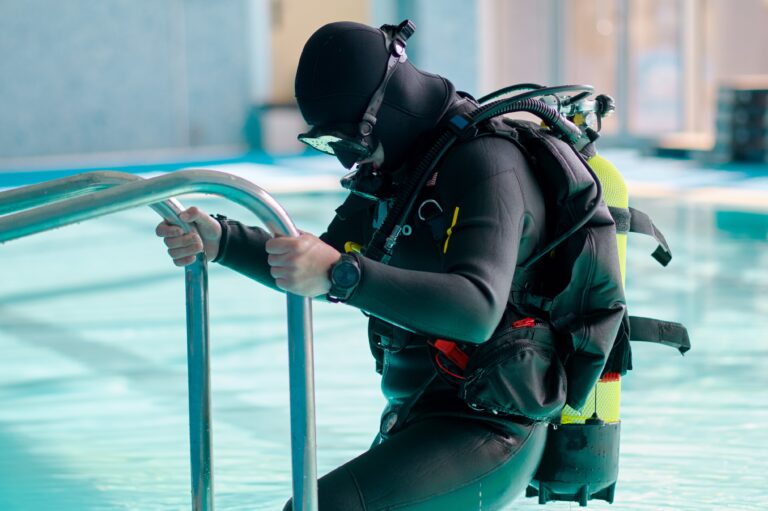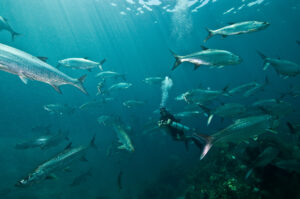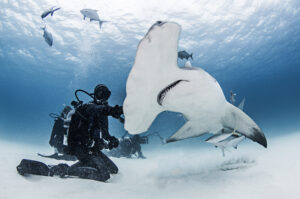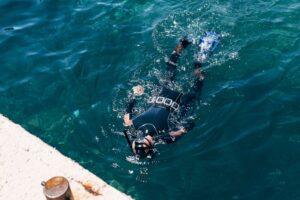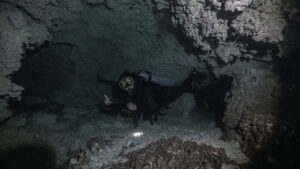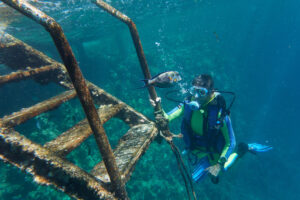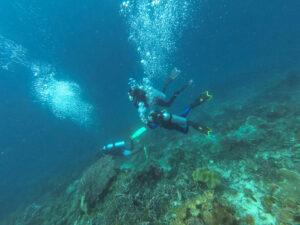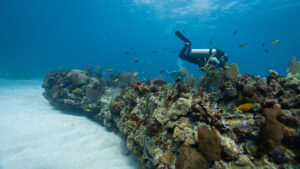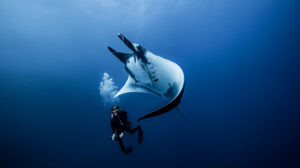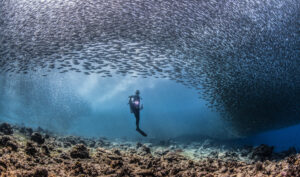What is a diving wetsuit?
A wetsuit is a specialized garment worn by divers and other water enthusiasts, designed to provide thermal insulation, protection from the elements, and buoyancy while submerged underwater. The purpose of a wetsuit is to allow the diver to maintain a comfortable body temperature in cold water environments by trapping a thin layer of water between the suit and the skin. This trapped water is then warmed by the body’s heat and serves as an insulating layer, preventing heat loss and enabling the diver to stay warm even in cold water.
History and Development of the Wetsuit
The invention of the diving wetsuit can be traced back to physicist and oceanographer Hugh Bradner in the early 1950s. Bradner, a researcher at the University of California, Berkeley, was working on a project for the United States Navy when he developed the first prototype of a neoprene wetsuit. Neoprene, a synthetic rubber, was discovered in 1930 by DuPont chemist Wallace Carothers and quickly gained popularity for its flexibility, durability, and insulating properties.
Bradner’s initial design for the wetsuit was simple: a two-piece garment consisting of a jacket and pants, made of neoprene material with nylon lining. This prototype was later refined and commercialized by companies such as O’Neill, Body Glove, and Rip Curl, which added features like zippers, reinforced knees, and adjustable straps to enhance the wetsuit’s fit, comfort, and durability.
Wetsuit Materials
Neoprene remains the primary material used in diving wetsuits due to its inherent qualities, including water resistance, elasticity, and insulation. However, recent advancements in materials science have led to the development of alternative materials that offer improved performance and comfort. These include:
Limestone-based neoprene
Limestone-based neoprene presents a groundbreaking innovation in the field of wetsuit materials, providing an environmentally conscious option compared to its petroleum-based counterpart. Extracted from naturally abundant calcium carbonate, this type of neoprene offers comparable attributes to traditional neoprene, including flexibility, water-resistance, and durability. The production process of limestone-based neoprene significantly reduces the reliance on non-renewable petroleum resources, making it a more sustainable option. This innovative material has the potential to revolutionize the wetsuit industry by striking a balance between performance and environmental consciousness.
Yamamoto neoprene
Yamamoto Neoprene, developed by the reputable Japanese company Yamamoto Corporation, has revolutionized the wetsuit industry. This unique type of neoprene, derived from limestone, boasts a superior nitrogen cell content. The heightened nitrogen content provides a unique blend of benefits, including exceptional lightness, enhanced flexibility, and superior warmth, making it a high-performing alternative to traditional neoprene. These benefits are largely due to the nitrogen cells which trap insulating air, thus increasing the material’s heat retention capacity while also reducing its weight.
Smoothskin neoprene
Smoothskin neoprene is a specialized form of neoprene that is engineered with a smooth, sealed outer layer. This innovative design is a result of the unique closed-cell structure of the neoprene, which contributes to its distinctive performance characteristics. The smooth outer layer significantly diminishes water absorption and mitigates wind resistance, thereby enhancing the wetsuit’s insulation and hydrodynamic properties. This makes Smoothskin neoprene an excellent choice for divers looking for a wetsuit material that provides superior warmth and streamlined movement underwater.
Wetsuit Types and Styles
Diving wetsuits come in various thicknesses, styles, and designs to suit different diving conditions and preferences. Some of the most common wetsuit types include:
Full wetsuit
A full wetsuit is a type of protective garment that envelops the entire body, extending from the wrists and ankles all the way up to the neck. Its comprehensive coverage serves a dual purpose: offering maximum insulation and protection. Crafted usually from neoprene, a material known for its excellent heat-retention properties, the full wetsuit is a diver’s trusted ally in colder water conditions. By creating a thin layer of water between the suit and the skin, which the body heats, it maintains the diver’s body temperature even amidst the chill of the deep. Apart from thermal protection, it also safeguards the diver against cuts, scrapes, and stings from marine creatures. Therefore, a full wetsuit is the perfect choice for divers exploring colder, potentially abrasive underwater environments.
Shorty wetsuit
A shorty wetsuit, as the name suggests, is a shorter version of a traditional wetsuit. It is designed to cover the diver’s torso, upper arms, and upper legs, leaving the lower arms and legs exposed. This type of wetsuit is particularly well-suited for warm water diving where the need for insulation is minimal, but a certain degree of protection is still desirable. The shorty wetsuit’s reduced coverage allows for enhanced flexibility and freedom of movement, making it a favorite among surfers, snorkelers, and divers in tropical waters. Despite its lesser material, it still provides ample protection against sunburn, abrasions, and stings.
Spring suit
A spring suit, or ‘springy’ as it is colloquially known, is a variant of a wetsuit that strikes a happy medium between warmth and flexibility. Similar in design to a shorty wetsuit, it differs in that it includes full-length sleeves but maintains short legs. This design element provides more insulation for the upper body while offering greater mobility for the lower body. Consequently, a spring suit is highly appropriate for diving in temperate waters where the temperature is not quite tropical but not as cold to necessitate a full wetsuit. It’s an ideal choice for those seeking versatility, comfort, and a balance between protection and flexibility.
Farmer John/Jane wetsuit
The Farmer John or Farmer Jane wetsuit, named for its resemblance to traditional farming overalls, is a unique two-piece wetsuit configuration. It features a sleeveless vest with full-length legs, paired with a separate long-sleeved jacket. This design allows for considerable flexibility in adjusting insulation levels based on the water temperature and the specific diving conditions. The bottom piece can be worn alone in warmer conditions, or the jacket can be added for additional warmth in cooler waters. The two-piece system also provides a broad range of motion, making it an excellent choice for divers who need to adapt quickly to varying water temperatures or who prioritize flexibility and comfort.
Approperiate Wetsuit Thickness for Diving
The thickness of a wetsuit is measured in millimeters (mm) and directly correlates with its insulation properties. Thicker wetsuits provide greater insulation and are better suited for colder water temperatures, while thinner wetsuits offer increased flexibility and are ideal for warmer waters. The most common wetsuit thicknesses include:
2mm Diving Wetsuits
The 2mm diving wetsuits are an ideal solution for aquatic activities in warmer water climates, specifically in temperatures of 75°F (24°C) and above. These suits are commonly chosen for their lightweight nature and flexibility, providing ample room for movement during activities such as snorkeling, surfing, or shallow diving. A popular choice for tropical destinations, these wetsuits offer a balance of protection and comfort. They provide a layer of insulation against the water, keeping the body warm, while also serving as a protective barrier against sun exposure, abrasion from coral or rocks, and stings from marine creatures.
3mm Diving Wetsuits
For a slightly cooler water environment, ranging from 65°F to 75°F (18°C to 24°C), 3mm diving wetsuits are the preferred choice. These suits deliver a moderate level of thermal insulation, making them appropriate for recreational diving and water sports in temperate climates. While offering greater warmth than their 2mm counterparts, they still maintain a degree of flexibility that allows for comfortable movement underwater. 3mm wetsuits are well-suited for divers venturing into slightly deeper waters where temperatures can drop, or for seasons when water temperatures are somewhat cooler.
5mm Diving Wetsuits
The 5mm diving wetsuits are engineered for colder water temperatures between 50°F and 65°F (10°C to 18°C). With an increased thickness, these suits offer superior insulation, making them suitable for cold-water diving activities. These are often the wetsuit of choice for scuba divers braving early spring or late fall waters, when temperatures are noticeably cooler. Despite their thicker material, these wetsuits are designed to offer a good balance of flexibility and warmth. They also provide enhanced buoyancy control, a critical factor for divers in colder environments.
7mm Diving Wetsuits
At the thicker end of the spectrum, the 7mm diving wetsuits provide maximum insulation, making them the optimal choice for water temperatures between 45°F and 60°F (7°C to 16°C). These suits are typically used for diving in very cold environments, such as ice diving or deep diving in cold-water regions. Their enhanced thickness offers the greatest level of thermal protection, ensuring that divers can stay warm even in extreme cold. Despite their bulk, these suits are designed with flexibility in mind, allowing divers to move efficiently underwater. They are also often used in conjunction with hooded vests or undergarments to provide additional insulation.
Additional Diving Wetsuit Features
Apart from thickness and style, diving wetsuits can be equipped with various features designed to enhance comfort, fit, and functionality. Some of these features include:
Back-zip or front-zip entry
The entry method of a wetsuit, either back-zip or front-zip, has significant implications for its overall functionality and convenience. Back-zip wetsuits have a vertically aligned zipper running from the base of the neck down the spine, providing a broad opening for users to slide in or out of the suit. This traditional design is widely used due to its ease of use, particularly for beginners. Conversely, front-zip wetsuits feature a zipper that diagonally traverses the chest area. This modern design is noted for providing easier entry and exit due to the expansive opening it offers. Beyond ease of use, front-zip wetsuits also have the added advantage of enhanced flexibility and mobility, as the absence of a back zipper allows for unrestricted movement of the torso.
Sealed seams
Sealed seams are a key feature of high-quality wetsuits, enhancing both the suit’s insulation properties and durability. To create these sealed seams, manufacturers employ different techniques such as gluing, blind-stitching, or using liquid tape. These methods are designed to prevent water from infiltrating the suit through the stitch holes, maintaining the diver’s body heat and therefore providing an insulated environment within the wetsuit. Furthermore, sealed seams contribute significantly to the wetsuit’s longevity by preventing fraying and wear, making them crucial for those who frequently engage in water-based activities.
Built-in hoods
For divers venturing into colder water temperatures, a wetsuit with a built-in hood can be an invaluable feature. The hood serves as an additional layer of insulation for the head and neck area, mitigating significant heat loss that occurs through the head while submerged. This feature is especially pertinent in colder climates or during the cooler months, as it aids in maintaining the body’s core temperature. By keeping the head warm and dry, an integrated hood also adds a level of comfort that enhances the overall diving experience.
Reinforced knees and elbows
The incorporation of reinforced knees and elbows in a wetsuit design is indicative of a thoughtful consideration for the durability and longevity of the garment. These areas, being high-contact and high-wear points, are prone to damage over time due to the constant friction experienced during activities like diving, surfing, or swimming. By utilizing durable fabrics or padding in these regions, manufacturers substantially increase the wetsuit’s resilience against wear and tear. This addition not only extends the life of the wetsuit but also provides extra comfort and protection to the wearer.
Ankle and wrist seals
The inclusion of seals at the wrists and ankles in a wetsuit design is a strategic measure aimed at minimizing water exchange within the suit. These seals, often made of flexible materials like neoprene, create a snug fit around these extremities, thereby limiting the inflow and outflow of water. This feature is crucial in maintaining the body’s warmth, as it prevents the influx of cold water and the loss of heat stored within the suit. For divers and water sports enthusiasts, wrist and ankle seals contribute significantly to their comfort and thermal protection during prolonged immersion in water.
Wetsuit Care and Maintenance
Proper care and maintenance can significantly extend the lifespan of a diving wetsuit. After each use, wetsuits should be rinsed with fresh water to remove salt, sand, and other debris. They should be hung to dry in a well-ventilated area, away from direct sunlight and heat sources. Periodic cleaning with a wetsuit-specific cleaner is recommended to remove bacteria and prevent the buildup of odors. Additionally, wetsuits should be stored in a cool, dry place, free from direct sunlight and heat.
Diving wetsuits play a crucial role in ensuring a safe and enjoyable diving experience by providing thermal insulation, protection, and buoyancy. Understanding the various types, materials, and features available can help divers select the perfect wetsuit for their specific needs and diving conditions. Proper care and maintenance will also ensure the longevity of the wetsuit, protecting the investment for many dives to come.

